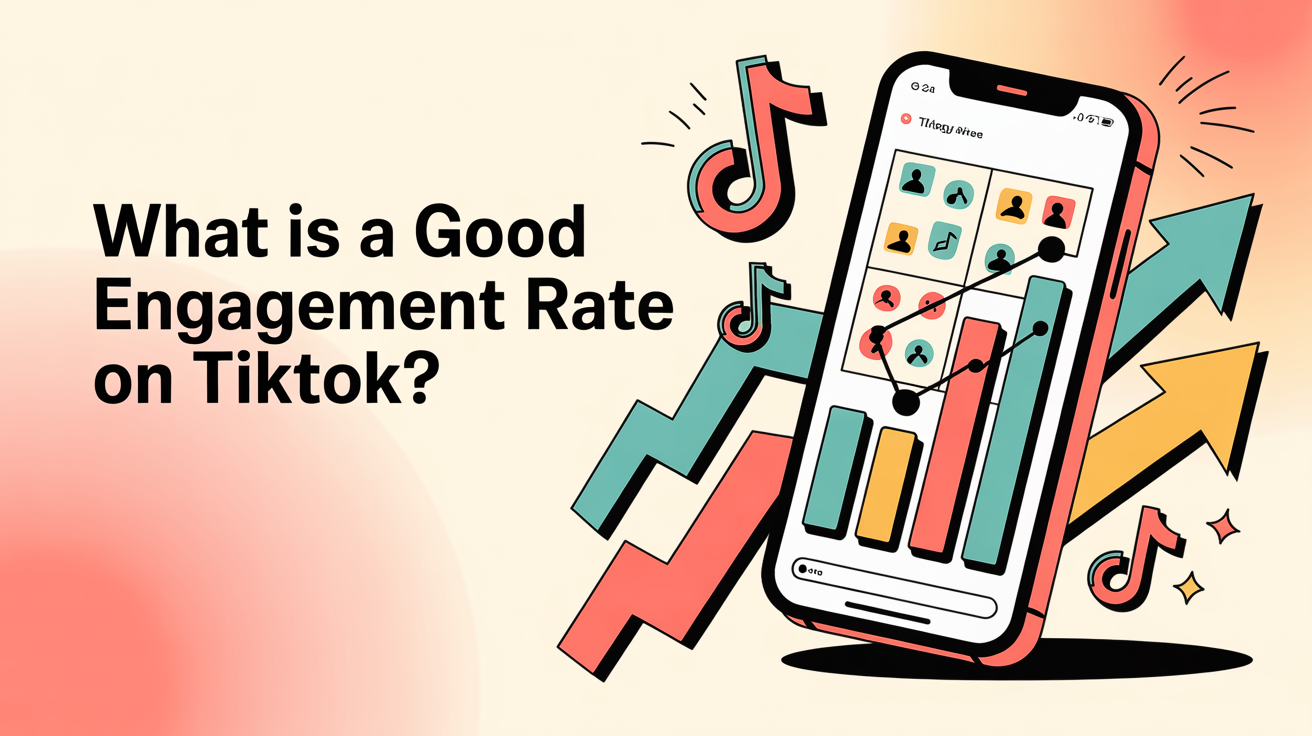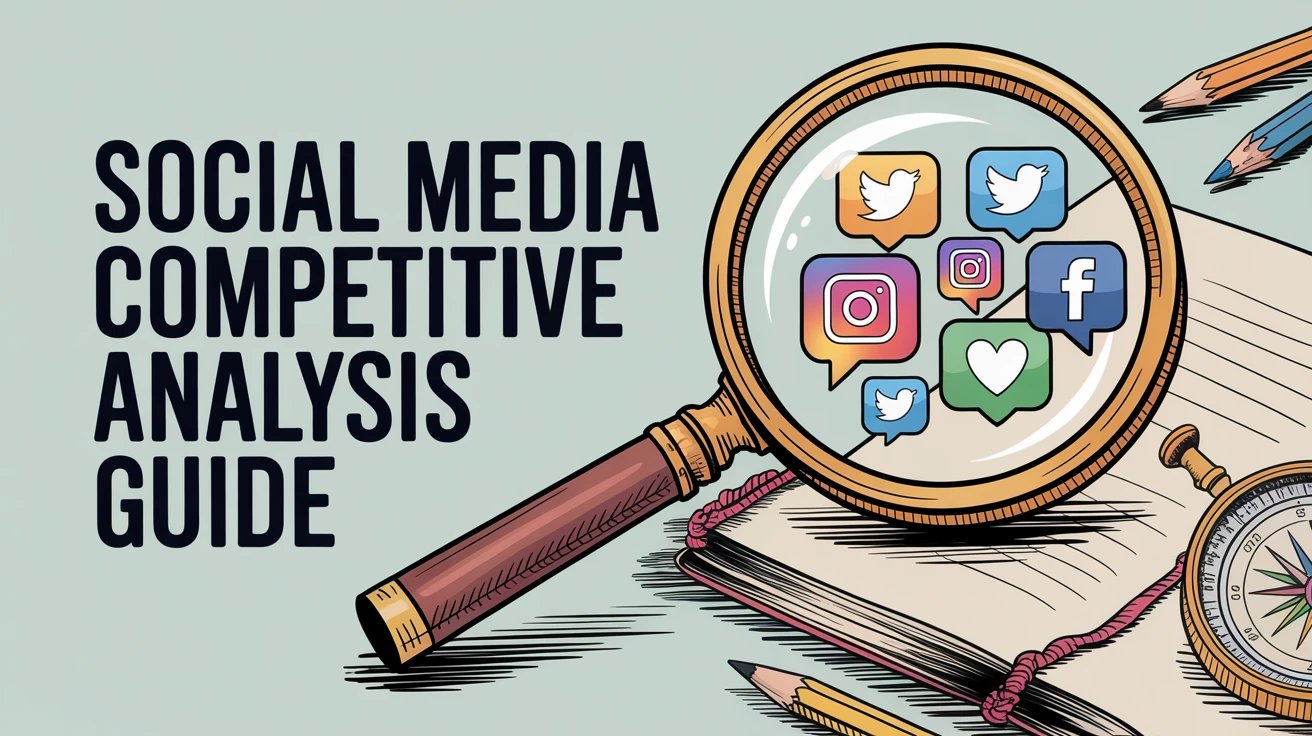If you're trying to make sense of your TikTok analytics, you've probably stared at your engagement rate and wondered: is this actually good? The answer isn't as simple as a single number. What counts as "good" depends on your account size, your niche, and honestly, who you're comparing yourself to.
TikTok has a reputation for ridiculously high engagement compared to other platforms. But those sky-high numbers also mean the bar is higher. A 2% engagement rate might be solid on Instagram, but on TikTok? That's probably a sign something needs adjusting.
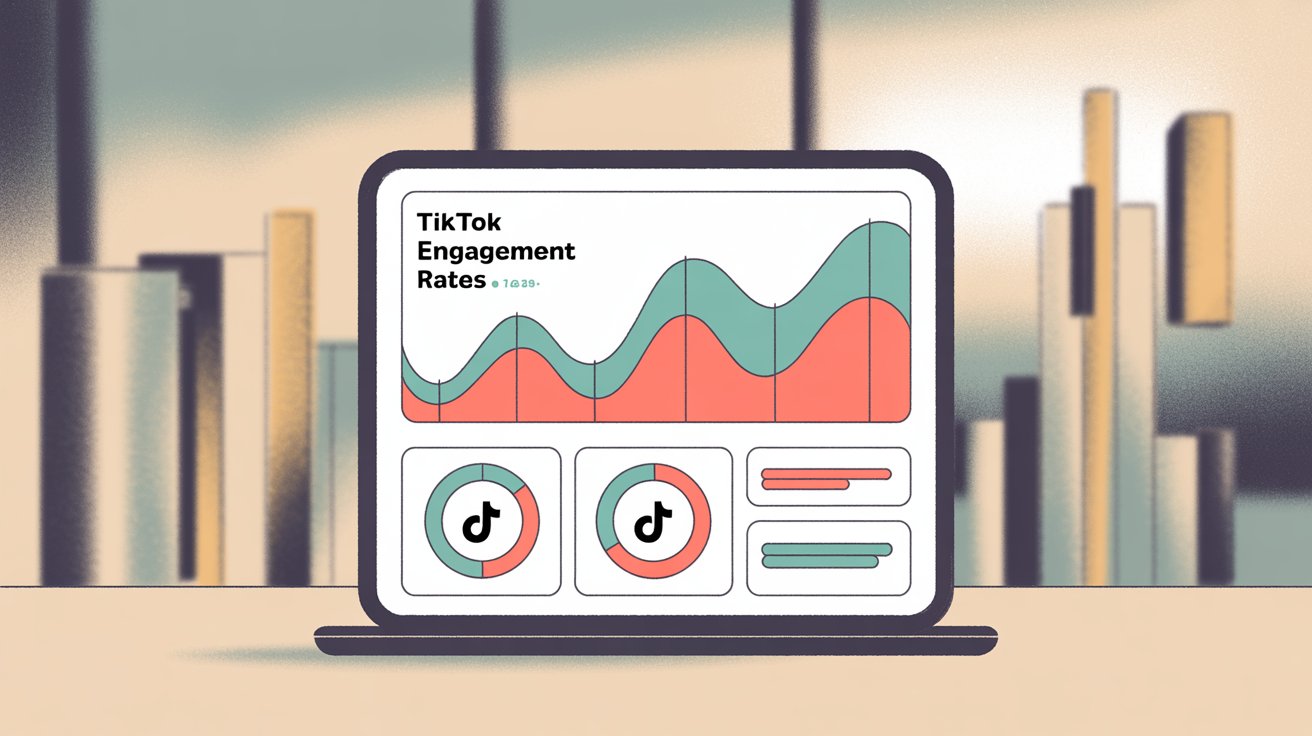
This guide breaks down the real benchmarks for 2025, walks through how to calculate your engagement rate correctly, and gives you practical ways to improve it. By the end, you'll know exactly where you stand and what to do about it.
How to Calculate TikTok Engagement Rate (Step-by-Step)
Engagement rate measures the percentage of people who actually interact with your content. On TikTok, that includes likes, comments, shares, and saves. The tricky part is there are two common ways to calculate it, and they'll give you different numbers.
Method 1: Engagement Rate Per Follower
Take all the interactions on a video (likes + comments + shares + saves), divide by your follower count, and multiply by 100. This tells you what portion of your followers engaged.
For example: 250 engagements on a post from an account with 1,000 followers equals a 25% engagement rate. This method is popular because it's consistent across platforms and gives you a sense of how well you're activating your existing audience.
Method 2: Engagement Rate Per View
Add up all engagements, divide by the video's view count, and multiply by 100. This measures how compelling your content was to everyone who watched it, not just your followers.
Most TikTok marketers prefer this method because videos regularly reach way beyond your follower base through the For You Page. TikTok analytics tools typically work this way too.
Both methods are valid. Just be clear about which one you're using when comparing numbers, because benchmarks will differ. Throughout this article, I'll note which calculation method applies to each benchmark.
Why TikTok Engagement Rate Matters More Than Follower Count
Engagement rate isn't just a vanity metric. It's basically a health check on how well your content resonates with viewers. High engagement means people aren't just scrolling past, they're stopping to like, comment, share, and save.
Why engagement is crucial:
→ The algorithm rewards engagement
TikTok's algorithm heavily favors videos with high engagement rates. More engagement signals to TikTok that your content is worth showing to even more people. This creates a snowball effect where strong engagement leads to greater reach, which leads to more engagement.
→ It signals a real community
If your audience regularly interacts with your content, you've built something more valuable than just a follower count. For influencers, this matters enormously. Brands would rather work with a creator who has 50,000 followers and an 8% engagement rate than someone with 500,000 followers but only 1% engagement. Why? Because that engaged audience is far more likely to take action on promotions.
→ It's real-time feedback
Lots of comments and shares usually mean the content struck a chord. Tracking which videos get above-average engagement helps you understand what your audience actually wants to see. You can use those insights to guide your content strategy toward what works.
→ It drives business results
Engagement isn't just about metrics. Highly engaged content tends to lead to more website clicks, app installs, and sales. The "TikTok made me buy it" phenomenon is real because engaged audiences trust what they're seeing enough to act on it.
Think of engagement rate as your content's vital signs. If it's healthy, you're on track. If it's weak, it's time to diagnose what's wrong and fix it.
TikTok Engagement Rate vs Instagram, YouTube, and Facebook
Understanding how TikTok compares to other social platforms helps frame what's actually "good" on the platform. Spoiler: TikTok crushes every other major platform when it comes to engagement rates.
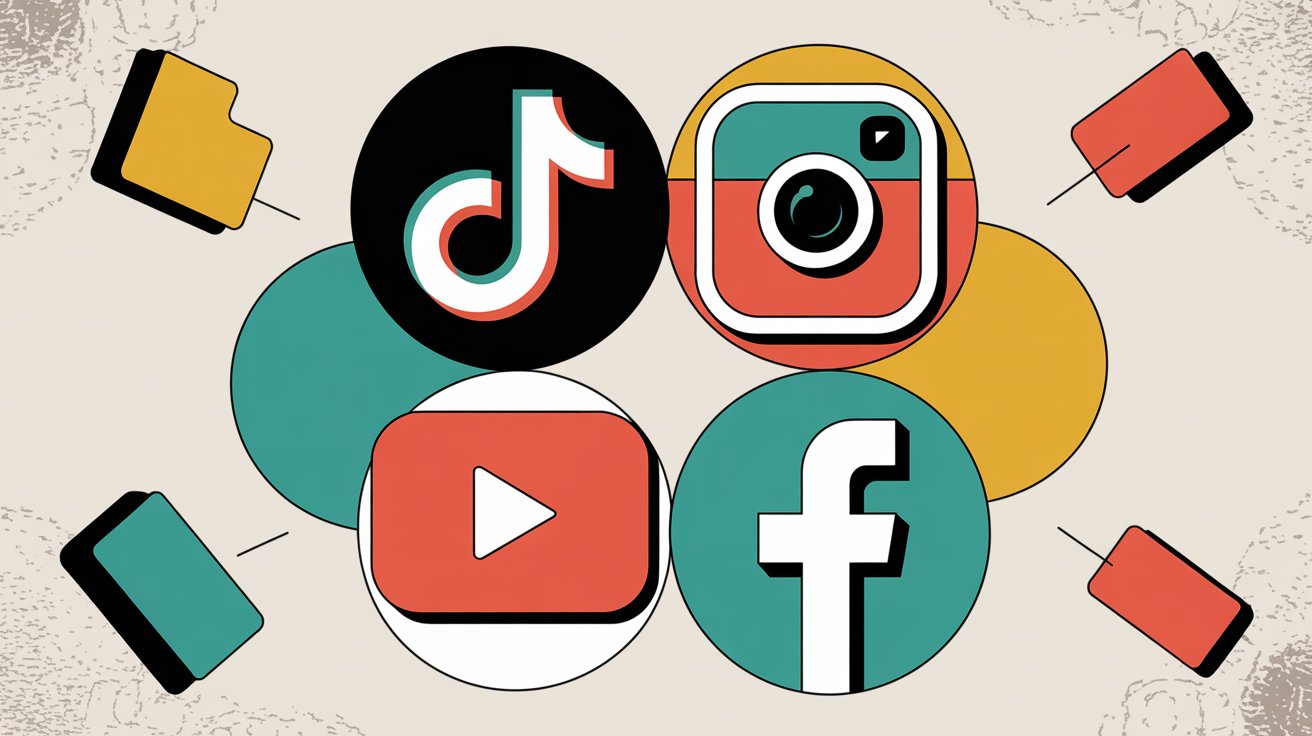
Here's how the platforms stack up:
|
Platform |
Average Engagement Rate |
Notes |
|---|---|---|
|
TikTok |
2.6% to 5% |
Brand averages 3-5%, creators often higher |
|
|
~0.7% per post |
Even Instagram Reels land between 1-3% |
|
|
0.1% to 0.2% |
Tiny fraction of TikTok |
|
YouTube |
<1% |
You can analyze YouTube Shorts to compare |
So if your TikTok engagement rate is 5x higher than your Instagram rate, that's completely normal. TikTok's format (short videos, For You Page discovery) naturally creates more interaction. The platform's design encourages people to engage quickly and often.
That said, the higher overall engagement on TikTok also means the bar for "good" is higher. A 3% engagement rate is stellar on Instagram but just average on TikTok.
What Is a Good Engagement Rate on TikTok? (2025 Benchmarks by Account Size)
Alright, what you actually came for. What counts as a "good" TikTok engagement rate in 2025?
The answer depends on your account size and niche, but here are the benchmarks you should know:
Average TikTok Engagement Rate in 2025
Most marketing experts consider an engagement rate above 5% to be solid on TikTok. Recent data shows the average content engagement rate was around 4.6% in 2024. So if you're consistently hitting above 5%, you're doing better than the typical TikTok video. Anything above 8-10% is often considered excellent.
Different reports give slightly different ranges, but there's a common thread. Research suggests anything in the 6-10% range is good engagement on TikTok. Industry analysis frames 2-5% as being strong, with 5%+ being exceptional. Many influencer tracking platforms consider around 10% to be great, especially for smaller creators.
The pattern is clear: roughly mid-to-high single digits is "good," and double digits is outstanding.
Good Engagement Rate by Follower Count (Nano to Mega Influencers)
Something that trips people up: engagement rate typically drops as your follower count grows. This is totally normal. As you reach a broader audience, you naturally pick up more passive viewers who watch but don't interact.
What's "good" is relative to your following:
|
Account Size |
Follower Range |
Good Engagement Rate |
Key Insight |
|---|---|---|---|
|
Nano/Micro |
Under 10K |
10%+ |
Highly connected, engaged audiences. Studies show micro-influencers with under 15K followers averaged 18% engagement |
|
Mid-tier |
10K-100K |
6-8% |
Still niche enough for strong interaction |
|
Macro |
100K-1M |
5-7% |
Maintaining 5%+ approaching 1M shows broad resonance |
|
Mega |
1M+ |
4-6% |
Some celebrities may drop below 3% and still be fine due to massive reach |
Don't get discouraged if your engagement rate dips as you grow. The key is maintaining a core engaged community even as your reach expands.
TikTok Engagement Rate by Industry and Niche (What's Normal for Your Content)
Your niche matters a lot when evaluating what's "good." What works for a dance meme account won't be the same for a B2B SaaS brand.
High-engagement niches:
• Sports teams and colleges: Often see 7-10% engagement because their passionate fanbases drive interactions up
• Niche entertainment or DIY craft channels: Might average around 5%
Lower-engagement niches:
• Beauty and fashion brands: Typically hover in the 2-4% range
• Finance and B2B: If you run a finance account getting 3% engagement rate, that's actually fantastic because the finance sector might average 1-2%
Always compare yourself to peers in your industry, not just generic benchmarks. Context is everything.
Is Your TikTok Engagement Rate Good Enough? (Quick Assessment)
Most everyday TikTok creators and brands should aim for at least a mid-single-digit engagement rate. If you're consistently above 5%, you're doing quite well by 2025 standards. Hitting double-digit percentages means you're either knocking it out of the park or you have a very small, devoted follower base (which is still valuable).
And if you're down in the 1-2% range? It's a signal to re-evaluate your content strategy. On TikTok, that's below average for all but the most massive accounts.
6 Factors That Affect Your TikTok Engagement Rate
Why do some TikToks get insane engagement while others flatline? Here are the key factors:
Content Quality and Relevance
This is number one, and it's not even close. TikTok users scroll fast, so content that hooks attention in the first second wins. Bright visuals, trending sounds, and snappy storytelling all help.
If your video immediately resonates with your target audience (makes them laugh, teaches them something useful, triggers an emotion), they're far more likely to like, comment, and share. Highly relevant content to your niche will drive repeat engagement as viewers feel "this is so me."

Avoid boring your audience with repetitive content or long-winded intros. Get to the point fast.
Audience Size and Loyalty
As I mentioned earlier, smaller creators often have higher engagement rates because their audience is tightly knit. A broader audience naturally includes more "lurkers" who watch but don't interact.
This doesn't mean growth is bad. It just means you need to focus on keeping a core engaged community even as your reach expands.
Posting Frequency and Consistency
Inconsistent posting can hurt your engagement. TikTok's algorithm and users reward creators who show up regularly.
Key considerations:
• Posting often (daily or a few times a week) gives you more chances to engage followers
• Only post frequently if quality stays high
• Big gaps in posting can make followers forget about you
• The algorithm may show your content to fewer people after long breaks
The key is finding a sustainable rhythm.
Timing and Trends
Viral trends on TikTok change weekly. Jumping on trending sounds, challenges, or hashtags can spike engagement because TikTok might boost that content to trend-watchers.
Similarly, posting when your followers are most active improves the immediate engagement a video gets, which can trigger more algorithmic promotion. Use TikTok analytics to identify when your audience is online.
Algorithm Preferences
TikTok's algorithm cares deeply about watch time and completion rate. If people watch your video all the way through and rewatch it, TikTok will show it to more viewers, creating more opportunities for engagement.
A 15-second highly engaging clip can often outperform a 2-minute video in terms of engagement rate. Early engagement (in the first few hours) also signals the algorithm to push it harder. That's why hooking your audience quickly matters so much.
Calls to Action and Interaction
Sometimes just asking can boost engagement. Many TikTok creators prompt viewers with questions or subtle requests like "comment if you agree" or "double-tap if you find this satisfying."
Engaging back with your audience matters too. Replying to comments, doing Duets or Stitches with followers, and going live to build community all encourage a culture of interaction.
Industry considerations: Different niches inherently get different engagement. Don't beat yourself up comparing apples to oranges. Focus on improving your own baseline and comparing to similar accounts.
How to Increase Your TikTok Engagement Rate (9 Proven Strategies)
If your engagement isn't where you want it, good news: TikTok offers tons of ways to improve. Here are strategies that actually work:
① Hook Viewers Immediately
The first 2-3 seconds of your video are critical. Use an eye-catching clip or say something intriguing right away to stop the scroll.
Start with a bold statement, a surprising visual, or a question your target viewer needs to hear answered. Cut dead air and get straight to the point. This improves watch time and the likelihood people will interact.
② Keep It Snappy
While longer TikToks can work (videos over 54 seconds still see around 6-7% engagement), shorter videos (15-30 seconds) generally hold attention better.

Higher completion rates often lead to more engagement. Don't stretch a video longer than it needs to be. Quick, concise, and engaging usually wins.
③ Use Trending Sounds and Themes
Pay attention to what's trending. Whether it's a viral sound clip, a dance, a hashtag challenge, or a meme format, incorporating trends (in a way that fits your content) makes your video instantly more relatable and shareable.
Benefits of trend participation:
→ Gets you in front of users who follow that trend
→ Signals to TikTok that your content is current
→ Increases discoverability through trend-related recommendations
Just put your own quality spin on it to stand out. Learn more about finding TikTok content ideas through monitoring.
④ Ask for Engagement (But Make It Natural)
There's nothing wrong with a gentle call to action. End your video with a question in text on screen or in your caption to encourage comments. For example, "What do you think? Let me know👇"
Or prompt viewers to duet or stitch your video. TikTok's algorithm notices when people remix your content as a sign of engagement.
Just avoid spammy or desperate requests. Make it fun and natural. A cooking TikTok might say "Would you try this recipe? 🍽️" which invites genuine responses.
⑤ Engage Back and Build Community
Don't be a one-way broadcaster. Like and reply to comments you get, especially in the first hour or two after posting. This not only boosts your comment count, it builds rapport and encourages more people to comment since they see you might respond.
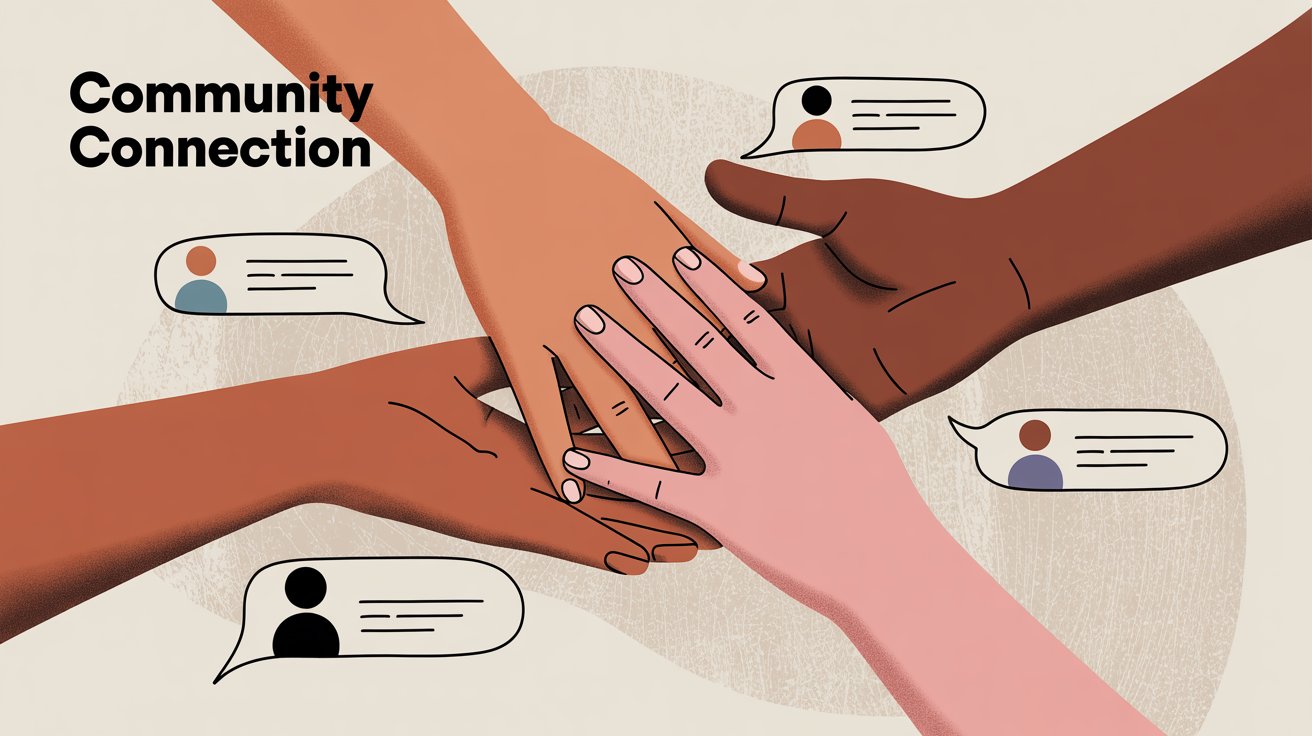
Creators who cultivate a community feel (inside jokes, familiar faces in comments, shared references) tend to sustain higher engagement over time.
⑥ Leverage TikTok Features
Use interactive features TikTok offers:
• Polls and Q&As
• Duets and stitches
• Effects and filters
• Captions and subtitles (make content accessible)
Even simple features like captions can improve engagement by making your content accessible. People are more likely to watch fully and engage if they can follow without sound.
Post Consistently and Time It Right
Set a posting schedule and stick to it. Whether that's daily or three times a week, consistency helps your audience know when to expect you.
Also, try posting when your audience is most active. If your followers tend to be online at 7pm, posting around then can give your video an early engagement boost. Use TikTok account analytics to find peak times, but also experiment. Sometimes posting during off-peak hours exposes you to new audiences.
Collaborate with Others
Working with other TikTokers can expose your content to a new engaged audience. Partner with creators in your niche for duets or shout-outs.
Often their followers will engage with your collab content, and some may become your followers too, increasing future engagement. Just ensure the partnership is authentic and the audiences align in interests.
Amp Up the Quality (Within TikTok's Vibe)
While TikTok favors an authentic, casual vibe, that doesn't mean you should ignore quality. Good lighting, clear audio, and sharp editing do make a difference, as long as your content still feels human.
Content that's overly polished or looks like a TV ad can turn TikTok viewers off. Aim for a sweet spot: look and sound clear and compelling, but stay genuine.
Analyze and Adapt
Keep an eye on your metrics. Which videos got the highest engagement rate? Study those to see what you did right:
• Topic choice
• Video style and length
• Hashtags used
• Posting time
Likewise, identify videos that underperformed and hypothesize why. Was the intro boring? Posted at a bad time? Off-brand topic?
Use TikTok analytics tools or third-party platforms to track your average engagement rate over time. Set experimental goals like "increase engagement from 4% to 6% in three months" and try different content tactics. TikTok trends evolve fast, so continuous learning is key.
By implementing these strategies, you should see your engagement improve. Even small boosts (going from 3% to 5%) represent a big jump in the number of people interacting with your content.
Best Tools to Track TikTok Engagement Rate (2025)
To improve engagement rate, you need to measure it consistently. Here's how to track your performance and benchmarks:
TikTok's Native Analytics
If you switch your account to a Pro or Business account (free in settings), TikTok provides built-in analytics. You can view each video's stats like views, likes, comments, and shares.
TikTok won't directly give you a percentage engagement rate, but you can easily calculate it: (engagements ÷ views) × 100 for any post. Use a spreadsheet to log your posts' engagement rates if you want to track trends.
Third-Party Analytics Tools : Shortimize
For deeper analysis or tracking multiple accounts, third-party tools can save you a ton of time.
Shortimize, for example, lets you track any public TikTok account or video and shows engagement metrics at both the account level and per post.
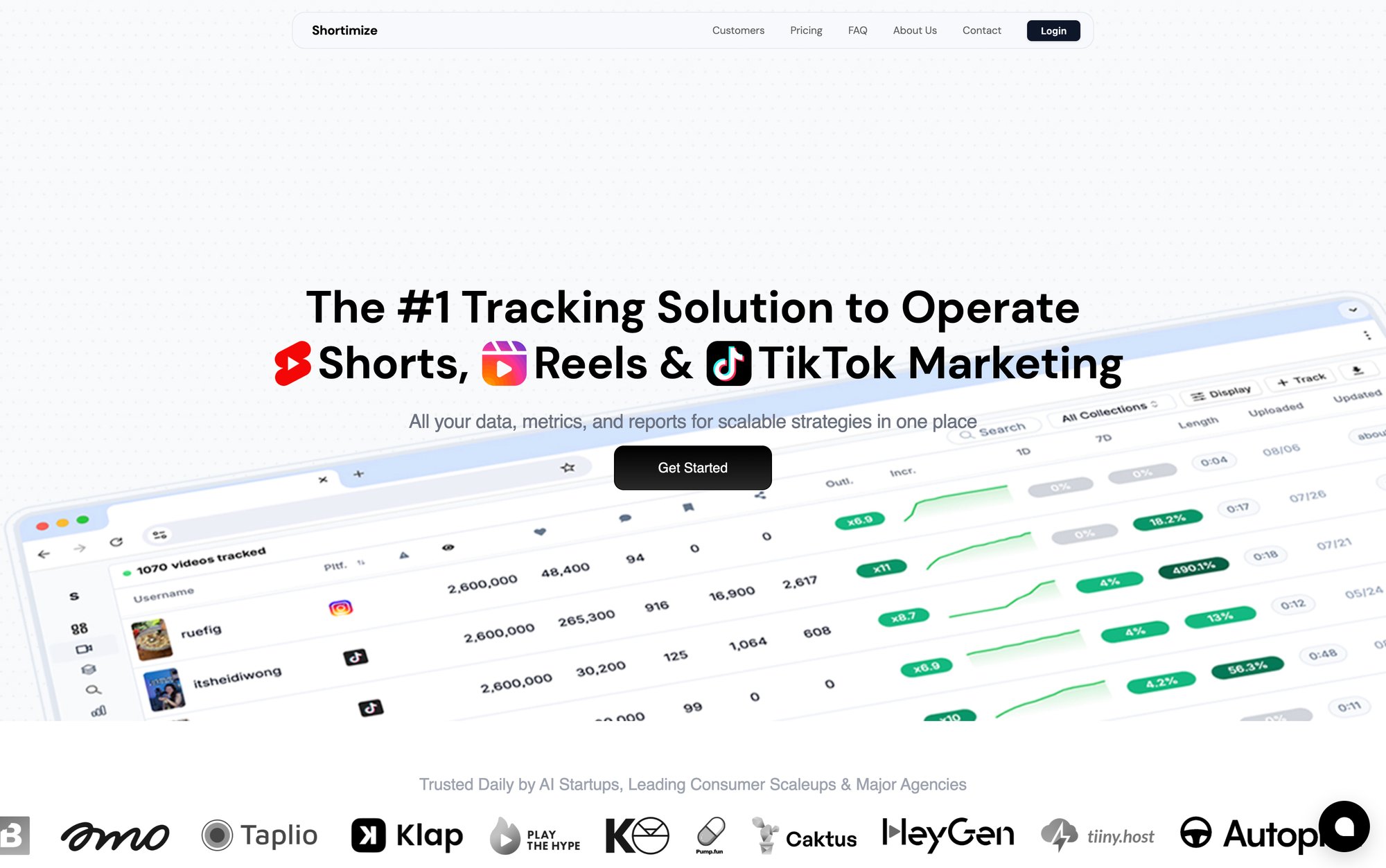
Key features:
• Track any public TikTok account or video with engagement metrics at both account level and per post
• Works across TikTok and Instagram Reels in one dashboard
• Also track YouTube Shorts alongside other platforms
• Automatically calculates engagement rate (by followers or views)
• Highlights which posts are outperforming your median
These tools make it easy to identify what content drives higher engagement without manually crunching numbers for every video. Learn more about social media monitoring tools for comprehensive tracking.
Benchmark Against Competitors
It's helpful to know how peers in your niche are doing. You might manually check a competitor's last five TikToks, calculate their average engagement rate, and see how you compare.
Some platforms (like Shortimize) let you create watchlists of competitors to monitor stats side by side. If your engagement lags behind a similar account, study their content for ideas on what might be working better. Check out Shortimize's guide on how to spy on your competitors' influencer strategy.
Track Over Time
Don't obsess over one video's engagement rate. Instead, watch the trend. Is your monthly average engagement rate going up or down?
Seasonal content or one-off viral hits can spike or dip your short-term numbers, so look at a larger sample. Aim to steadily improve your baseline. For instance, maybe three months ago you averaged 3%, and now it's 5%. That's real progress.
Also, be aware of platform-wide changes. TikTok's overall engagement has slowly normalized (the average content engagement rate dipped from around 5.8% in 2023 to 4.6% in 2024), so factor that in when comparing year over year.
Focus on Quality, Not Just Quantity
Finally, remember engagement rate is just one metric. It's crucial, but also consider the quality of engagement.
A hundred genuine comments are worth more than a thousand bot likes. Look at your comments content and sentiment:
• Are people tagging friends (a great sign)?
• Asking questions?
• Or just dropping emojis?
High-quality engagement (thoughtful comments, shares, remixes) is the gold standard that can't be fully captured by a single percentage.
TikTok Engagement Rate: Quick Reference Guide
If you remember nothing else from this guide, keep these points in mind:
• "Good" TikTok engagement is generally in the 5-10% range for most accounts. It's higher for small creators and a bit lower for mega-popular accounts. If you're consistently above 5%, you're doing better than the average TikTok video.
• TikTok's engagement rates crush other platforms. Don't be alarmed if you see only 2% on Instagram but 6% on TikTok. That's completely normal and one of the main reasons brands and creators invest so heavily in TikTok content.
• Always interpret engagement in context. Compare yourself to accounts of similar size or within your industry. What's great for one category might be average for another. A 3% engagement rate for a finance account might be excellent, while the same number for a campus life channel might be mediocre.
• Focus on content and community. There's no hack or algorithm gimmick that beats simply making content people love and engaging with your audience authentically. Do that consistently, and the likes and comments will follow.
• Use data to your advantage. Track your performance, learn from your wins and losses, and iterate. Even top TikTokers constantly adjust their strategy to keep engagement up as trends shift.
• Don't chase vanity metrics, chase improvement. Instead of obsessing over hitting a certain percentage, aim to continuously improve your own engagement rate over time by making better and more relevant TikToks. Growth is the real goal.

By understanding these benchmarks and implementing the strategies in this guide, you're well positioned to thrive on TikTok. A "good" engagement rate isn't a fixed number. It's one that meets or exceeds your goals and shows your content strategy is connecting with the right audience.
Keep creating, stay flexible, and watch that engagement climb.
TikTok Engagement Rate FAQ (Common Questions Answered)
What's the average TikTok engagement rate in 2025?
The average TikTok engagement rate hovers around 4-5% in 2025. Recent data shows the average content engagement rate was about 4.6% in 2024. This varies significantly by account size and niche. Smaller creators (under 10K followers) often see averages of 10%+ while mega accounts might average 4-6%.
Is a 3% engagement rate good on TikTok?
It depends on context. For most TikTok accounts, 3% is below the average of 4-5%, suggesting room for improvement. However, for very large accounts (1M+ followers) or certain corporate niches, 3% might be acceptable.
Compare yourself to similar accounts in your niche rather than generic benchmarks. If peers are hitting 6-8%, then 3% indicates you should adjust your strategy.
Should I calculate engagement rate by followers or by views?
Most TikTok marketers prefer calculating by views because TikTok videos regularly reach beyond your follower base through the For You Page. Engagement rate per view measures how compelling your content was to everyone who watched it.
However, calculating by followers is useful for understanding how well you're activating your existing audience. Just be consistent with whichever method you choose. Use TikTok analytics tools to track both metrics easily.
Why is my engagement rate dropping as I gain followers?
This is completely normal. As your follower count grows, you naturally reach a broader, more diverse audience that includes more passive viewers. Your core engaged community might stay the same size while your total followers increase, causing the percentage to drop.
Focus on maintaining that core community even as you grow. Learn how to retain new followers after virality.
How often should I post to improve my engagement rate?
Consistency matters more than frequency. Find a sustainable posting rhythm (whether that's daily, three times a week, or whatever you can maintain with high quality) and stick to it.
Posting often gives you more chances to engage followers, but only if quality stays high. Inconsistent posting or long gaps can hurt engagement because followers forget about you and the algorithm shows your content to fewer people.
Does video length affect engagement rate?
Generally yes, but it's not black and white. Shorter videos (15-30 seconds) typically have higher completion rates, which can lead to better engagement. However, longer videos can still perform well (videos over 54 seconds averaged around 6.7% engagement).
The key is keeping your video as long as it needs to be to deliver value, and no longer. If you can hook viewers and keep them watching a longer video, the engagement can be just as strong. Check out tips on analyzing TikTok audio choices for viewer retention.
How can I track my competitors' TikTok engagement rates?
You can manually check a competitor's recent videos and calculate their engagement rate using the formula (likes + comments + shares) ÷ views × 100. However, this gets tedious for multiple accounts.
Tools like Shortimize let you track any public TikTok account and automatically calculate engagement metrics. You can create watchlists to monitor multiple competitors side by side, which makes benchmarking much easier. Learn more about conducting TikTok competitor analysis.
What counts as "engagement" on TikTok?
Engagement includes all interactions with your video: likes, comments, shares, and saves. Some calculations also include follows that happen from a specific video and profile views. TikTok's algorithm pays special attention to watch time and completion rate as well, since these signal how compelling your content is even if someone doesn't formally "engage."
Can I improve engagement rate without following trends?
Yes, absolutely. While jumping on trends can give you quick visibility boosts, sustainable engagement comes from creating consistently valuable content for your specific audience.
Focus on understanding what your audience wants, delivering high-quality content that resonates with them, and building genuine community through interaction. Plenty of successful creators thrive without constantly chasing every trend by carving out their own unique niche and voice. Explore social media engagement tracking best practices for long-term growth.
Should I buy engagement to boost my rate?
Never. Fake engagement (purchased likes, comments from bots, etc.) might temporarily inflate your numbers, but it doesn't help and often hurts.
TikTok's algorithm can detect inauthentic engagement patterns. More importantly, fake engagement doesn't translate to real business results or genuine community. Focus on earning authentic engagement through quality content and real audience connection.
